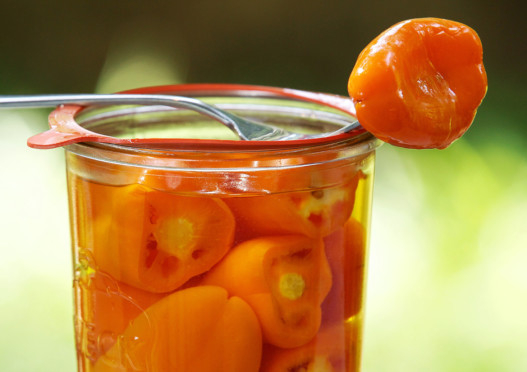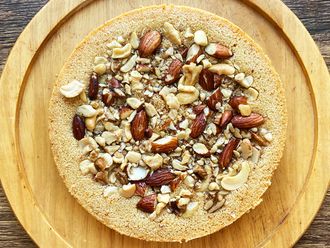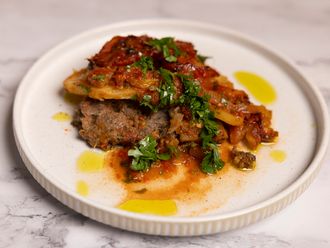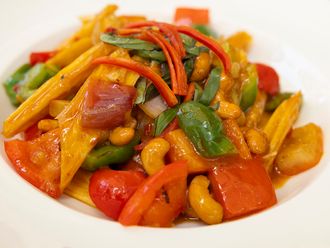
In late summer, when the sun is strong and bright, all peppers begin to blush with colour. Whether sweet or hot, every variety of capsicum relies on the warmth of soil and sun to ripen and turn red, orange, yellow or purple. The heat brings out the flowers, too, so the plants use this last burst to produce like mad. If you garden or have a community-supported agriculture (CSA) share, you know the pleasure — and the challenge — of the bounty.
Enter the pickled pepper: a briny, crunchy, brightly coloured snack that bumps up the interest quotient in any meal. This is a refrigerator pickle, with no canning necessary. In fact, the heat of a boiling-water canner plays havoc with the crisp factor, so this recipe works only when the results are kept cold.
The ratios are immutable. One part vinegar to one part non-chlorinated water. One tablespoon of salt for each quart of liquid. After that, it’s up for grabs. Any vinegar will do; experiment with rice wine and fruit vinegars. Add a garlic clove, pickling spice, dill seed, Indian whole spices, pink or Sichuan peppercorns, sugar or honey, citrus zest. The accompanying recipe will get you started: think of it as a road map.
Preparation of the pickle is paramount. Slice off the stem and green skirt (the top, at the base of the stem) unless the pepper is just-this-minute picked. Wilting stems don’t look or feel appealing when pickled. Keep snacking peppers, aka Yummy Peppers, whole. If you’re a heat-seeker, do the same with jalapenos. Pierce peppers with a paring knife to encourage the brine to seep into the middle of the each pepper in the jar. Core with a small spoon or scoop to extract the seeds, if you wish. I remove them just before serving because the seeds carry flavour, too. Whole pickled peppers are a flavourful, textural addition to any meal.
Jalapenos, sliced into rings, are convenient for scattering over scrambled eggs, tacos and burritos or stirring into corn bread batter. Serranos work as rings, although I prefer them in strips for sneaking into quesadillas and tortas.
Play with this recipe to find your personal pickled pepper, the one you prefer. Then pop a few jars in the refrigerator; the peppers last a month or longer (in my experience, the rings and strips hold up longer than whole peppers), and, although it seems impossible, we’re getting awfully close to that pickled-pepper-friendly, post-Thanksgiving turkey sandwich.
WHOLE PICKLED SNACKING PEPPERS
18 servings (makes 3 pints)
In this one instance, as this is a refrigerator pickle and will not be processed, there is no need to use a special canning jar. Use any pretty jar (with a tight-fitting lid) lurking in the back of the cabinet, or brine the pickles in a bowl you can cover.
MAKE AHEAD: The whole peppers need 5 days’ marinating time before serving. The peppers can be refrigerated for at least a month.
From Cathy Barrow, author of Mrs. Wheelbarrow’s Practical Pantry: Recipes and Techniques for Year-Round Preserving (Norton, November 2014).
Ingredients
About 450g whole, small orange snacking peppers (often called Yummy Peppers; see VARIATION)
3 tsp pickling spice (optional)
3 strips lemon peel, each about 2 inches long (optional)
2 cups non-chlorinated water
1 cup distilled white vinegar
1 cup apple cider vinegar
1 tbs kosher salt
1 tbs sugar
3 cloves garlic (optional)
Steps
Trim off and discard the stem ends of the peppers. Use a paring knife to stab each pepper three or four times, so the brine will suffuse the pepper inside and out. Snugly pack the peppers into the jars. If using, add 1 tsp pickling spice and 1 lemon peel strip to each jar.
Combine the water, white and cider vinegars, salt, sugar and garlic, if using, in a medium saucepan; bring to a boil over high heat for 1 minute, making sure the salt and sugar have dissolved, then pour enough brine over the peppers to submerge them; there should be brine left over. Allow the peppers to absorb the brine for 15 minutes, then add more brine, pressing down on the peppers to encourage them to stay submerged. Repeat the brine additions every 15 minutes or so for the next hour. You might not use all of the brine in the end.
Cap and refrigerate for five days before serving.
VARIATION: If you’d rather cut the whole peppers into strips or rings, they will brine more rapidly and will be ready to eat in two days.
Ingredients are too variable for a meaningful analysis.
— Washington Post
















